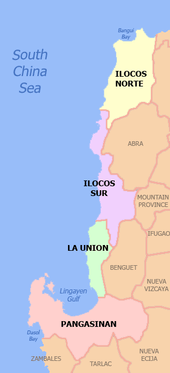La Union
La Union (Tagalog pronunciation: [la ˈuɲon]) is a province in the Philippines located in the Ilocos Region in the island of Luzon. Its capital is the city of San Fernando, which also serves as the regional center of the whole Ilocos Region.
La Union | |
|---|---|
| Province of La Union | |
Welcome arch at the La Union-Ilocos Sur border | |
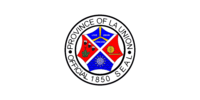 Flag  Seal | |
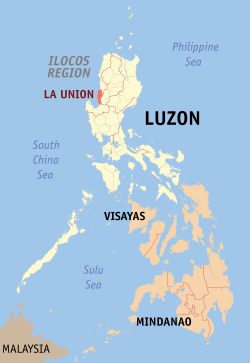 Location in the Philippines | |
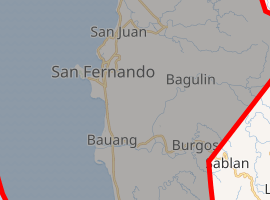
| |
| Coordinates: 16°30′N 120°25′E | |
| Country | Philippines |
| Region | Ilocos Region (Region I) |
| Founded | March 2, 1850 |
| Capital | San Fernando |
| Government | |
| • Type | Sangguniang Panlalawigan |
| • Governor | Francisco Emmanuel R. Ortega, III (PDP-Laban) |
| • Vice Governor | Mario Eduardo C. Ortega (NUP) |
| Area | |
| • Total | 1,497.70 km2 (578.27 sq mi) |
| Area rank | 69th out of 81 |
| Highest elevation | 1,888 m (6,194 ft) |
| Population (2015 census)[2] | |
| • Total | 786,653 |
| • Rank | 36th out of 81 |
| • Density | 530/km2 (1,400/sq mi) |
| • Density rank | 9th out of 81 |
| Divisions | |
| • Independent cities | 0 |
| • Component cities | |
| • Municipalities | |
| • Barangays | 576 |
| • Districts | 1st and 2nd districts of La Union |
| Time zone | UTC+8 (PHT) |
| ZIP code | 2500–2520 |
| IDD : area code | +63 (0)72 |
| ISO 3166 code | PH-LUN |
| Languages | |
| Website | www |
The province is bordered by Ilocos Sur to the north, Benguet to the east, Pangasinan to the south and to the west by the shores of the South China Sea (West Philippine Sea).
History
Formation
La Unión, "The Union" in English, was formed in 1850 when the Spanish colonial government of Governor-General Antonio Maria Blanco merged the three southern towns of Ilocos Sur province, the nine northern towns of Pangasinan, and the western towns of Benguet to the east (Eastern Pais del Igorotes in the Cordilleras). Pangasinans were the majority in the new province because most towns had been in the province of Pangasinan.
On October 29, 1849, Governor General Claveria issued a promovido to fuse the Pangasinan-Ilocos-Cordillera areas into La Union. On March 2, 1850, Governor General Antonio Maria Blanco signed the Superior Decreto of La Union (34th province from Cebu-1565), with Captain Toribio Ruiz de la Escalera as the first Gobernador Military y Politico. Isabella II of Spain decreed the province's creation on April 18, 1854. In 1661, Andres Malong (Pangasinan) failed to recover La Union from the Spaniards after the Battle of Agoo.[3]
1896 Philippine revolution
In 1896, the people of La Union began a revolt against the Spaniards, who had called La Union "Una Provincia Modelo" ("A Model Province"), led by Manuel Tinio Y Bondoc under Emilio Aguinaldo. The Americans collaborated with the Filipinos to end the Spanish.
American colonial era
Dr. Lucino Almeida became the Presidente Provincial of the American regime, followed by the appointment of La Union's first civil governor in 1901, Don Joaquin Joaquino Ortega.[4]
World War II
La Union had great strategic significance both for allied and Japanese forces.
On December 22, 1941, the Japanese 4th Tank Regiment and the 47th Infantry Regiment under the command of Col Isamu Yanagi supported by a massive flotilla of navy ships tried to land in Agoo to make it one of three major beachheads for the Japanese Invasion of Lingayen Gulf, although weather dispersed their forces and made them deploy on a wide stretch of beach that ranged from Agoo to as far south as Damortis. These forces later met the commonwealth defence forces - consisting of the 26th Cavalry Regiment (Philippine Scouts), the Philippine 21st Division, the Philippine 11th Division, and the newly formed Philippine 71st Division - in what would later be called the Battle of Rosario.[5]
On January 4, 1945, La Union was liberated by the Battle of San Fernando and Bacsil Ridge.[3]
Martial Law
Although economically affected by the rapid peso devaluation brought about by unbridled election spending heading into the 1969 presidential elections,[6][7] political life in La Union was not significantly impacted by Ferdinand Marcos’ declaration of Martial Law in 1972.[8]
The powerful family factions which had dominated La Union politics since before the American colonial era largely remained in place, although the family of Congressman Jose D. Aspiras became much more prominent after he became Marcos’ Tourism Minister. The main political change was the increased power of regional and provincial offices of national agencies, whose directors were answerable directly to Marcos.[8]
This technique used by Marcos to consolidate political power did not get much resistance in the Ilocos Region,[8] including La Union, which had strong ethnic associations with the Marcos family.[9] The Marcos administration’s use of violent methods for stifling dissent thus mostly took place in other, non-Ilocano provinces, such as nearby Abra, Kalinga, and Mountain Province.[9]
But there were still La Union natives who were willing to object to the authoritarian practices and abuses of the Marcos administration, despite personal risk.[10][11] This included San-Fernando-raised student activists Romulo and Armando Palabay, UP Students and La Union National High School alumni who were imprisoned for their protest activities, tortured at Camp Olivas in Pampanga, and later separately killed before the end of Martial Law.[12] The martyrdom of Romulo (age 22) and Armando (age 21) was later honored when their names were etched on the Wall of Remembrance at the Philippines’ Bantayog ng mga Bayani, which honors the heroes and martyrs who fought the authoritarian regime.[13]
Agoo, La Union native Antonio L. Mabutas had become Archbishop of Davao by the time of Martial Law, and spoke actively against the Human rights abuses of that time,[14][15] particulaly the torture and killings of church workers. The pastoral letter he wrote against Martial law, “Reign of Terror in the Countryside,” is notable for having been the first pastoral to be written against Marcos' martial law administration.[14]
Geography
La Union covers a total area of 1,497.70 square kilometres (578.27 sq mi)[16] occupying the central‑southern section of the Ilocos Region in Luzon. The province is bordered by Ilocos Sur to the north, Benguet to the east, Pangasinan to the south, and to the west by the South China Sea.
La Union is 273 kilometres (170 mi) north of Metro Manila and 57 kilometres (35 mi) northwest of Baguio. The land area of the province is 149,770 hectares (370,100 acres).[1]
Like most of the Ilocos Region, the province is squeezed in by the Cordillera mountain range to the east and the South China Sea to the west. Yet, unlike other portions of Luzon and the Philippines' two other island groupings, the Visayas and Mindanao, La Union experiences a rather arid and prolonged dry season with little precipitation to be expected between the months of November and May.
- Landscape along Rosario
- Tapuakan River along Pugo near the base of the Cordillera mountains
- Coast along Agoo overlooking the South China Sea
Administrative divisions
La Union comprises 19 municipalities and 1 component city,[17] all of which are organized into two legislative districts.[16]
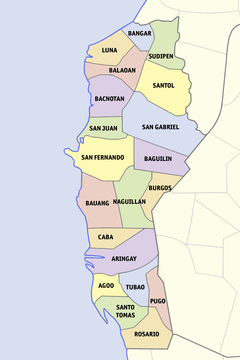
- † Provincial capital and component city
- Municipality
| |||||||||||||||||||||||||||||||||||||||||||||||||||||||||||||||||||||||||||||||||||||||||||||||||||||||||||||||||||||||||||||||||||||||||||||||||||||||||||||||||||||||||||||||||||||||||||||||||||||||||||||||||||||||||||||||||||||||||||||||||||||||||||||||||||||||||||||||||||||||||||||||||||||||||||||||||
Barangays
La Union has a total of 576 barangays comprising its 19 municipalities and 1 city.[17]
The most populous barangay in the province is Sevilla in the City of San Fernando with a population of 10,612 in the 2010 census. If cities are excluded, Central East (Poblacion) in the municipality of Bauang has the highest number of inhabitants, at 4,249. Caggao in Bangar has the lowest with only 170.[17]
Demographics
|
| ||||||||||||||||||||||||||||||||||||||||||||||||
| Source: Philippine Statistics Authority[2][17][18] | |||||||||||||||||||||||||||||||||||||||||||||||||
The population of La Union in the 2015 census was 786,653 people,[2] with a density of 530 inhabitants per square kilometre or 1,400 inhabitants per square mile.
The province is predominantly Ilocano (over 90% based on recent census data) and Roman Catholic. Communities of Pangasinans thrive mostly in the southwestern portion of the province while Cordillerans live in the Cordillera foothills. In September 2012, the province of La Union passed an ordinance recognizing Ilocano (Iloko) as an official provincial language alongside Filipino and English, as national and official languages of the Philippines, respectively.[19][20]
According to the Philippine Statistics Authority report in 2012, the province has the longest life expectancy in the country at 78.3 years.[21]
Economy
La Union is known for its softbroom and tourism industry.[22] The economy is diversified with service, manufacturing, and agricultural industries spread throughout the province. The Port of San Fernando operates as an increasingly active shipping point, and the former American airbase Wallace Air Station, having been converted into a business and industrial area, helps to facilitate such commercial activity.
The major products of the province include: hand-woven blankets (Inabel), softbrooms, baskets, pottery, rice wine (tapuey), sugarcane wine (basi), sugarcane vinegar, wood craft, bamboo craft, native rice cakes, antique-finish furniture, dried fish, coconuts, sea urchins, malunggay and pebble stones.
Currently, 80% of the income of the province comes from San Juan.
Education
La Union has 333 public elementary schools, 56 private elementary schools, 79 public high schools, 51 private secondary schools, 20 Colleges and 5 State Universities.[23]
Provincial government and politics
Just as the national government, La Union provincial government is divided into three branches: executive, legislative and judiciary. The judicial branch is administered solely by the Supreme Court of the Philippines. The LGUs have control of the executive and legislative branch.
The executive branch is composed of the governor for the provinces, mayor for the cities and municipalities, and the barangay captain for the barangays.[24]
The legislative branch is composed of the Sangguniang Panlalawigan (provincial assembly) for the provinces, Sangguniang Panlungsod (city assembly) for the cities, Sangguniang Bayan (town assembly) for the municipalities, Sangguniang Barangay (barangay council), and the Sangguniang Kabataan for the youth sector.
The seat of government is vested upon the mayor and other elected officers who hold office at the City Hall of San Fernando. The Sanguniang Bayan is the center of legislation, stationed in the Speaker Pro-Tempore Francisco I. Ortega Building, the Legislative Building at the back of the Capitol.
Elected officials
La Union is governed by Francisco Emmanuel "Pacoy" R. Ortega III, the chief executive, his vice governor, Mario Ortega, and 13 board members.[25]
Governors
American colonization
- Lucino Almeida (1901)
- Don Joaquin Joaquino Ortega (1901–1904)
- Joaquin Luna (1904–1907)
- Sixto Zandueta (1907–1909)
- Francisco Zandueta (1909–1912)
- Mauro Ortiz (1912–1916)
- Tomas de Guzman (1916)
- Mauro Ortiz (1916–1918)
- Pio Ancheta (1918–1921)
- Thomas de Guzman (1922–1923)
- Juan Lucero (1923–1928)
- Thomas de Guzman (1928–1931)
- Pio Ancheta (1931)
- Mauro Ortiz (1931–1934)
- Juan Rivera (1934–1937)
- Francisco Nisce, (1937–1940)
- Bernardo Gapuz (1940)
Japanese occupation
- Jorge Camacho (1941–1942)
- Bonifacio Tadiar (1942–1944)
Postwar and present eras
- Agaton Yaranon (1946–1947)
- Doroteo Aguila (1948–1951)
- Juan Carbonell (1952–1955)
- Bernardo Gapuz (1956–1959)
- Eulogio de Guzman, (1960–1967)
- Juvenal Guerrero (1968–1977)
- Tomas Asprer, (1977–1986)
- Robert V. Dulay (1986–1987)
- Joaquin Ortega (1988–1992)
- Justo O. Orros (1992–2001)
- Victor F. Ortega, (2001–2007)
- Manuel C. Ortega (2007–2016)
- Francisco Emmanuel R. Ortega III, (2016–present)
Court system
The Supreme Court of the Philippines recognizes La Union (inter alia) regional trial courts and metropolitan or municipal trial courts within the province and towns, that have an overall jurisdiction in the populace of the province and towns, respectively.[26]
Batas Pambansa Blg. 129, "The Judiciary Reorganization Act of 1980", as amended, created Regional, Metropolitan, Municipal Trial and Circuit Courts. The Third Judicial Region includes RTCs in La Union xxx Sec. 14. Regional Trial Courts. (a) Fifty-seven Regional Trial Judges shall be commissioned for the First Judicial Region. Nine branches (Branches XXVI to XXXIV) for the province of La Union, Branches XXVI to XXX with seats at San Fernando, Branches XXXI and XXXII at Agoo, Branch XXXIII at Bauang, and Branch XXXIV at Balaoan;
The law also created Metropolitan Trial Courts in each metropolitan area established by law, a Municipal Trial Court in each of the other cities or municipalities, and a Municipal Circuit Trial Court in each circuit comprising such cities and/or municipalities as are grouped together pursuant to law: three branches for Cabanatuan City; in every city which does not form part of a metropolitan area, there is also a Municipal Trial Court with one branch, except as provided: Two branches for San Fernando, La Union;[27]
The courts of law are stationed in Halls of Justices of the Province and towns. In La Union, the Regional Trial Court is stationed at the Bulwagan ng Katarungan or Halls of Justice in San Fernando, La Union and other Regional Trial Courts in Bauang and Agoo, La Union.
Notable people
- Magnolia Antonino (1915–2010) – Senator of the Philippines
- Manuel Arguilla (1911 - 1944) - writer, patriot, and martyr
- Jose D. Aspiras - congressman and former Secretary of Tourism
- Rafael Buenaventura - Governor of the Bangko Sentral ng Pilipinas
- Anacleto Diaz (1878 - 1945) – Associate Justice of the Supreme Court of the Philippines
- Gloria Diaz (born 1951) – Miss Philippines 1969, Miss Universe 1969
- Vice Ganda – Singer, actor, comedian
- JB Magsaysay (born 1980) – Pinoy Big Brother (season 1) housemate; actor, public servant and businessman
- Bienvenido Nebres (born 1940) - Filipino mathematician, academic, National Scientist of the Philippines, former Provincial Superior of the Society of Jesus in the Philippines
- Camilo Osias (1889–1976) – Filipino politician, twice for a short time president of the Senate of the Philippines.
- Armando Palabay (1953-1974) - Filipino human rights activist and martyr honored at the Bantayog ng mga Bayani
- Diego Silang (1730–1763) – a revolutionary leader
- Jessica Soho- award-winning news anchor
- José B. Nísperos (1887–1922) First Asian and Filipino to win US Medal of Honor
References
- "List of Provinces". PSGC Interactive. Makati City, Philippines: National Statistical Coordination Board. Archived from the original on 11 January 2013. Retrieved 30 July 2013.
- Census of Population (2015). "Region I (Ilocos Region)". Total Population by Province, City, Municipality and Barangay. PSA. Retrieved 20 June 2016.
- "La Union Profile: La Union History - Province of La Union :: Official Website". Archived from the original on 2015-09-27. Retrieved 2014-04-25.
- La Union Profile: Gallery of Governors - Province of La Union :: Official Website
- Dull, Paul S. (1978). A Battle History of the Imperial Japanese Navy, 1941- 1945. Naval Institute Press. pp. 29–31. ISBN 1299324614.
- Balisacan, A. M.; Hill, Hal (2003). The Philippine Economy: Development, Policies, and Challenges. Oxford University Press. ISBN 9780195158984.
- Diola, Camille. "Debt, deprivation and spoils of dictatorship - 31 years of amnesia". The Philippine Star. Archived from the original on 26 June 2017. Retrieved 2 May 2018.
- Turner, Mark M. (1989) Elites and Power in a Philippine Town. Under Martial Law, 1972-76. Philippine Studies 37: 283-300.
- Cortes, Rosario Mendoza. (1990) Pangasinan, 1901-1986: A Political, Socioeconomic and Cultural History. New Day Publishers.
- "From 1987: 'A Damaged Culture' in the Philippines - The Atlantic". Archived from the original on 2016-10-28. Retrieved 2020-01-22.
- Manila Today. Mula Sigwa hanggang Commune hanggang EDSA: mga kabataangmartir at bayani ng UP.2016-01-27 https://manilatoday.net/fqs-martyrs/
- "PALABAY, Armando D. – Bantayog ng mga Bayani". bantayog.org. Retrieved 2020-01-22.
- Burgonio, TJ Museum puts a face on little-known martial law martyrs Philippine Daily Inquirer 2008-09-21 https://barangayrp.wordpress.com/2008/09/21/museum-puts-a-face-on-little-known-martial-law-martyrs/
- "Honoring Davao's Contributions to the Struggle for Rights, Freedom". Bantayog ng mga Bayani. Archived from the original on 2018-02-28. Retrieved 8 February 2020.
- Maglana, MAgz (2017-07-10). "VOICES FROM MINDANAO: Fear is not a good foundation for getting Mindanao out of the rut". MindaNews. Archived from the original on 2020-02-08. Retrieved 8 February 2020.
- "Province: La Union". PSGC Interactive. Quezon City, Philippines: Philippine Statistics Authority. Retrieved 8 January 2016.
- Census of Population and Housing (2010). "Region I (Ilocos Region)". Total Population by Province, City, Municipality and Barangay. NSO. Retrieved 29 June 2016.
- "Philippines Census Of Population of all LGUs 1903-2007". archive.org. Philippine Statistics Authority. Retrieved 14 February 2017.
- http://pia.gov.ph/news/articles/3151493148553%5B%5D
- http://www.philstar.com/nation/2012/09/19/850488/iloko-la-unions-official-language
- HDI Tables. Philippine Statistics Authority. Retrieved 2018-11-13.
- Rudio, Israel O. "La Union Soft Brooms: The First and the Original". Provincial Government of La Union (Official Website). Retrieved 18 May 2016.
- "Education". Provincial Government of La Union. Archived from the original on 27 September 2010. Retrieved 16 April 2016.
- Local Government Code of the Philippines, Book III Archived 2009-03-26 at the Wayback Machine, Department of Interior and Local Government official website.
- "Gobierno ti La Union". Provincial Government of La Union (Official Website). Retrieved 18 May 2016.
- Philippine Laws, Statutes And Codes - Chan Robles Virtual Law Library
- "Batas Pambansa Bilang 129; An Act Reorganizing the Judiciary, Appropriating Funds Therefor, and for Other Purposes". Chan Robles Virtual Law Library. 14 August 1981. Retrieved 18 May 2016.
External links


- Official Website of the Provincial Government of La Union
- Philippine Standard Geographic Code
